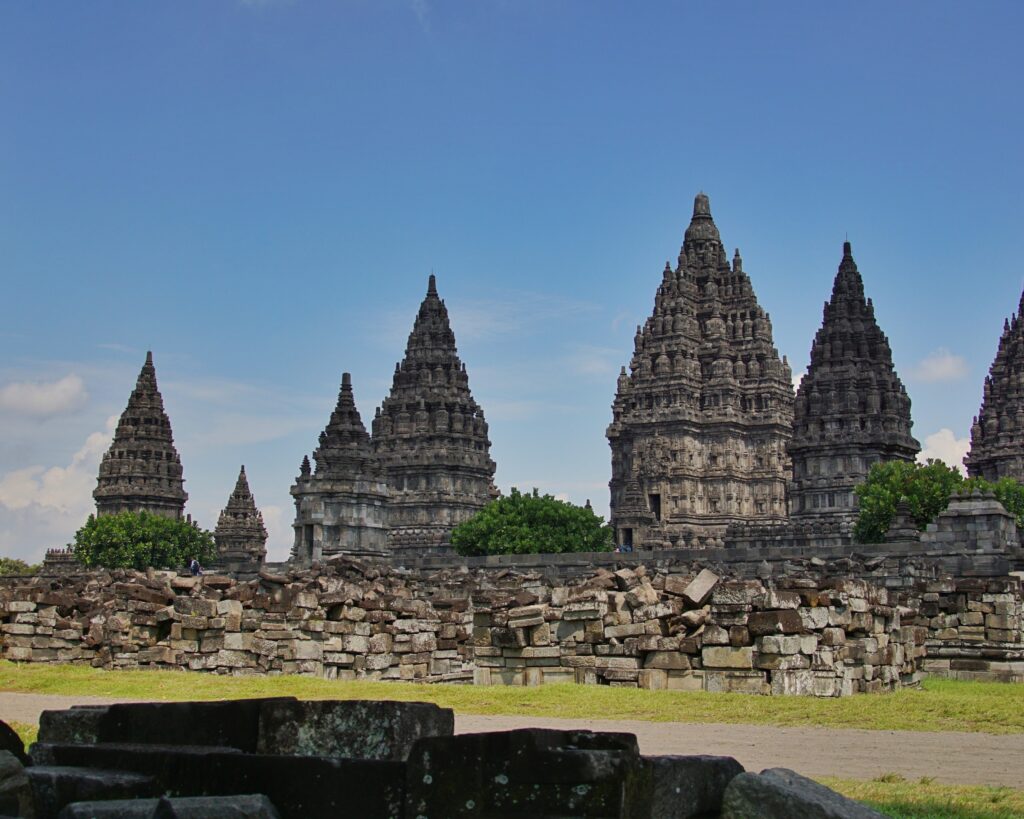Rising dramatically from the plains of Central Java, Prambanan Temple is a magnificent reminder of Indonesia’s rich spiritual and architectural heritage. As the largest Hindu temple complex in Southeast Asia, Prambanan is both a historical marvel and a living legend — a place where myth, art, and devotion come together in perfect harmony.
Located just 17 kilometers east of Yogyakarta, Prambanan was built in the 9th century during the reign of the Sanjaya Dynasty. It was dedicated to the Hindu trinity: Brahma the Creator, Vishnu the Preserver, and Shiva the Destroyer — with the central temple devoted to Shiva towering 47 meters into the sky. Known locally as Roro Jonggrang, the temple complex is as famous for its dramatic silhouette as it is for the captivating story behind its name.
The legend of Roro Jonggrang tells of a beautiful princess who was courted by a powerful prince named Bandung Bondowoso. To avoid marriage, she challenged him to build 1,000 temples in a single night. With help from supernatural forces, he completed 999 temples — but before he could finish the last one, Roro Jonggrang tricked him by creating the illusion of dawn. In fury, the prince cursed her and turned her into stone — and to this day, locals believe the statue of Durga inside the Shiva temple is none other than Roro Jonggrang herself.
Prambanan’s architecture is a stunning example of ancient Hindu artistry. The temple complex originally contained over 240 individual structures, arranged in a sacred symmetrical layout. Today, the main site showcases eight principal shrines and eight smaller ones, each intricately carved with scenes from Hindu epics such as the Ramayana and the Mahabharata. These stone carvings, filled with expressive figures and symbolic motifs, narrate age-old tales of divine battles, cosmic balance, and moral duty.
What makes Prambanan especially captivating is its sense of movement and life. Unlike the serene stillness of Buddhist Borobudur, Prambanan bursts with energy. The towering spires seem to dance skyward, echoing the rhythm of celestial music. The bas-reliefs appear in motion, as gods ride their vehicles, warriors engage in battle, and sages offer prayers to the heavens.

Despite centuries of earthquakes, volcanic eruptions, and political changes, Prambanan has endured. After a long period of abandonment, the temple was rediscovered in the 18th century and restoration efforts began in the early 20th century. Though many of the original structures are now in ruins, the central shrines have been meticulously rebuilt, and Prambanan was declared a UNESCO World Heritage Site in 1991.
Visiting Prambanan is a deeply immersive experience. As you walk through its courtyards and climb its stone staircases, you can feel the sacred geometry beneath your feet and the ancient energy in the air. Whether you’re admiring the sunset glow on the spires or attending the famous Ramayana Ballet — a captivating outdoor performance held at night against the temple backdrop — Prambanan offers a glimpse into the soul of Java’s spiritual and artistic identity.
The temple is often paired with Borobudur in cultural itineraries, showcasing the region’s unique blend of Hindu and Buddhist legacies. While Borobudur speaks of meditation and inner peace, Prambanan tells stories of drama, power, and divine interplay — two sacred sites, two contrasting philosophies, both timeless in their allure.
Beyond the main complex, the wider Prambanan archaeological park includes smaller temples like Sewu, Lumbung, and Bubrah, each offering quieter, less crowded experiences. These lesser-known gems are perfect for travelers who want to connect with the past away from the main tourist paths.
Whether you’re drawn by the myths, the architecture, or the atmosphere, Prambanan Temple is a destination that stirs the imagination and leaves a lasting imprint on the heart. It’s not just a place you visit — it’s a world you step into.
